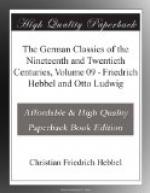Thus far none of Ludwig’s writings, aside from a mere trifle or two, had found their way before the public. As many as five or six regular dramas had been completed, but none had been printed, none performed. But now he finished his Hereditary Forester and with it made a deep impression upon his influential friend Eduard Devrient, the famous actor of the Dresden court theatre. Through Devrient’s mediation the drama was accepted at Dresden and, although its reception by the public was at first a divided one, it was at once recognized by friend and foe as a literary and theatrical event of great significance. Though late, yet all of a sudden, Ludwig, like Byron, awoke to find himself famous. When, in 1852, he at last felt able to marry the woman of his love, his life battle seemed to have been won for good. In the same year, 1852, he published his second great drama, The Maccabeans, which, though not attaining the popularity of the Hereditary Forester, did even more perhaps to enhance the poet’s fame. He could now count among the steadily widening circle of his friends and admirers men like Julian Schmidt, the prominent critic and editor, Gustav Freytag, and Berthold Auerbach. At Auerbach’s suggestion, Ludwig for awhile turned to narrative literature and in the years 1855 and 1856 published his two best stories, the Heiterethei and Between Heaven and Earth—the former again the more popular, the latter of higher literary merit. These brief years from 1850 to 1856 were the zenith of Ludwig’s career, the height of his productivity as an artist and of his success and happiness as a man. But already the shadows were gathering which were to cast such a deep gloom over the last years of the poet’s life.
In 1856 he was again stricken by what seemed to be the same mysterious illness, never fully explained, that had befallen him in Leipzig. He recovered, to be sure, for the time being, but his ailments returned again and again. From about 1860 Ludwig practically never was a well man. Confined to the house and soon to his bed, he slowly wasted away. The tenderest care of his devoted wife and the affection of a few loyal friends could do but little to relieve the most excruciating pain or to keep away the actual want that began to knock at his door. Ludwig had never learned to look upon his art as a commercial asset; his few published works had never brought him much




